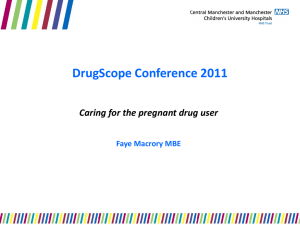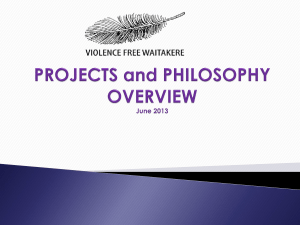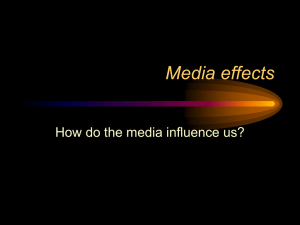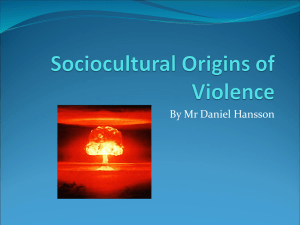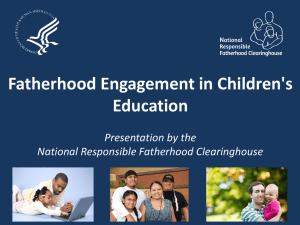August 2012 Training Power Point
advertisement
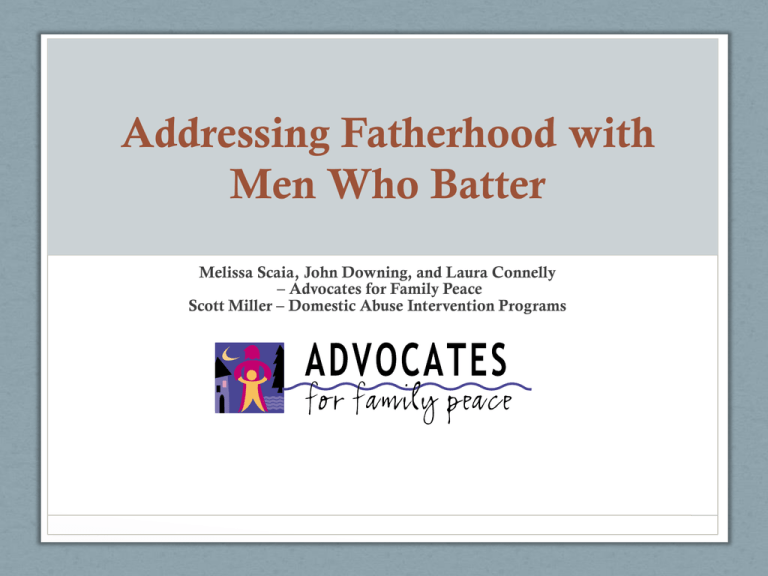
Addressing Fatherhood with Men Who Batter Melissa Scaia, John Downing, and Laura Connelly – Advocates for Family Peace Scott Miller – Domestic Abuse Intervention Programs History of working with men who batter and addressing fatherhood Fatherhood Goals • Goal for the curriculum: Add curricula and sessions to BIP programming that focuses on men as fathers and parenting partners • Community / Systemic Goal: Every man who uses supervised visitation and exchange for battering will also participate in the IPMF Goal for the development of this curriculum: • To help end violence against women and children by motivating men to become better fathers (or father figures) and more supportive parenting partners. Introduction to the beliefs about men who batter and fatherhood • Most men who batter are fathers • Most of the men have developed belief systems similar to their own fathers • Last 30 years, BIPs have developed around the country to address men’s violence against women • Very little time has been spent on men as fathers and as co-parents/parallel-parents • Greater empathy by men toward their children’s experiences of the violence than toward their partners’ experiences Why Should We Focus on Fathers? Most men who batter have some level of contact with their children. Many battered mothers report that their abusers purposefully involve children in violent events (Edelson, 2006). Men who batter systematically undermine and interfere with battered mothers’ parenting in multiple ways (Bancroft, 2002). The violence perpetrated in the home is used to control the behavior of the other members in the family. Battered women want their children to have “safe” contact with the father. On average, children exposed to adult domestic violence exhibit more difficulties than those not exposed. The difficulties can vary in range and extremity in behavioral and emotional functioning and cognitive functioning and attitudes (Edleson, 2006). Most men in a batterers intervention program (BIP) are fathers. Many men who batter are visiting parents in a supervised visitation center. History of the Fathering After Violence (FAV) Project • AFFP was chosen as a pilot site by the Family Violence Prevention Fund as part of the Safe Havens: Supervised Visitation and Safe Exchange grant program of OVW • Facilitators’ experiences in groups with men who have been abusive • Blandin Foundation, Northland Foundation, Minneapolis Foundation and Bush Foundation Funding • Research, Focus Groups, and Interviews A Shared Understanding of Domestic Violence Theory and Fatherhood A Shared Understanding: The Blueprint for Safety 1. Adhere to an interagency approach and collective intervention goals 2. Build attention to the context and severity of abuse into each intervention 3. Recognize that most domestic violence is a patterned crime requiring continuing engagement with victims and offenders 4. Ensure sure and swift consequences for continued abuse 5. Use the power of the criminal justice system to send messages of help and accountability 6. Act in ways that reduce unintended consequences and the disparity of impact on victims and offenders A Shared Understanding (cont’d) • Men's use of violence towards their current/expartner should be considered when determining access to their children. • All intervention practices must reflect an understanding of the interdependence of mother's and children's safety. Theoretical Framework for understanding fathering by men who batter • Men who batter parent differently than other fathers and systematically undermine and interfere with battered mothers’ parenting in multiple ways (Bancroft, 2002). • Most battered women want the children to have contact with the father – as long as it is safe for the children. • Our culture closely ties fatherhood to dominance and strength • Men who batter often believe that the children’s mother and children should provide unquestioning compliance. • Most men who batter to do not believe that if they have harmed the mother that they have harmed the children Why Does Domestic Violence Happen? 1. Diagnosable pathologies 2. It’s the relationship isn’t it? 3. Lenora Walker’s Cycle of Violence 4. Maintaining a system of dominance Diagnosable Pathology • The offender’s violence is explained through the diagnosis • The focus is the individual rather than social construction Therapy, chemical dependency treatment or parenting evaluations and treatment It’s the Relationship Isn’t It? The violence is a product of each person’s choices Interventions could be couple’s therapy, family therapy, and/or parent/child therapy. The Cycle of Violence Psychological explanation for domestic violence • tension-building • explosion • honeymoon Since anger is the driving force, managing it becomes the intervention. Child management techniques to address anger with children. System of Dominance • System of power and control tactics • Includes: • Physical violence • Sexual violence • Other tactics on Power and Control Wheel • Men battering their family is socially constructed • Need to balance power differential by using power of the state Domestic Abuse Intervention Programs Men’s vs. Women’s Use of Violence • Types of violence used • Intent of violence • Impact of the violence • Addressing parenting Entitlement Oppression and Resistance Oppression Resistance Domestic Abuse Intervention Programs Oppression and Resistance Healthy Relationship Violence Domestic Abuse Intervention Programs Critical Dialogue Learning Critical Dialogue: The Impact of My Parents on Me • Triad groups – learn from each other; ask questions to have a deeper understanding; practice dialogue Not a “parenting” curriculum and addressing fatherhood work with men who batter Not a parenting curriculum • Traditional parenting curriculum seeks to provide parents with skills to parent children as circumstances arise (child management techniques) and to increase men’s knowledge of stages of “normal” child development • Knowing child development stages + entitlement WILL STILL EQUAL = battering • This curriculum focuses on the entitlement that men have in relationships to their children and the children’s mother as a parenting partner • Intended to be incorporated into and/or with a BIP Example of Missy and Scott • Example of Missy and Scott • If Randy’s beliefs aren’t non-violent, then any skill taught will be used with entitlement and violent beliefs behind it Coordinating a Response to Fathers Who Batter When are parenting skills classes appropriate? What are the risks? What beliefs does a father need to implement skills? Who should skills programs be connected to? The Four Themes of the Fatherhood Work with Men Who Batter from curriculum “Addressing Fatherhood with Men Who Batter” Theme One: Examining Men’s Own Childhood Experiences with their Father Theme Two: The Impact and Effects of Men’s Abusive Behaviors on their Children Theme Three: Becoming a Child-Centered Father Theme Four: Examining How Men Can Be Respectful and Non-abusive of Their Children’s Mother and of the Mother-Child Relationship Fatherhood Log • Addresses each theme 1) Childhood experiences with your own father 2) Impact of your children and your children’s mother 3) Becoming a more nurturing, child-centered father 4) Respecting and supporting the woman as a parenting partner Implementing practice, philosophy, and principles with men who batter as fathers Written Curriculum, DVD, and future Trainings • Written curriculum, “Addressing Fatherhood with Men Who Batter” = $100 • Written by Melissa Scaia, MPA, Laura Connelly, and John Downing • Forward by: Ellen Pence, PhD • Edited by: John Connelly, Scott Miller, and Jane Sadusky o DVD = $125 • Four vignettes • 911 call o Purchase Curriculum and DVD at: www.stopdomesticabuse.org or www.theduluthmodel.org Contact information Advocates for Family Peace 1611 NW 4th Street Grand Rapids, MN 55744 218-326-0388 mscaia@stopdomesticabuse.org www.stopdomesticabuse.org Domestic Abuse Intervention Programs 202 East Superior Street Duluth, MN 55802 smiller@theduluthmodel.org www.theduluthmodel.org Resources Mending the Sacred Hoop www.msh-ta.org Battered Women’s Justice Project www.bwjp.org Domestic Abuse Intervention Project www.duluth-model.org Praxis International www.praxisinternational.org Advocates for Family Peace www.stopdomesticabuse.org

